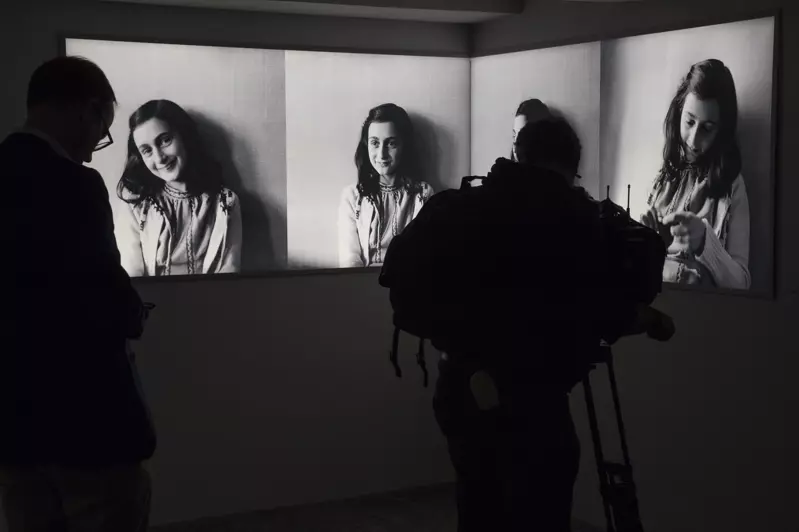安妮为何被抓成二战之谜 主嫌疑为救子曝藏身处
中央社 | 海牙
01/18/2022

纳粹大屠杀受害少女安妮法兰克藏身处为何曝光,成为悬而未决的二战谜团,前FBI探员率领的团队经过6年悬案调查,发现一名犹太公证人疑似为了救自己的孩子而出卖安妮一家人。
美国联邦调查局(FBI)退休探员潘科克(Vince Pankoke)和大约20名历史学家、犯罪学家和数据专家组成的团队调查发现,主嫌可能是较不为人知的犹太公证人范登柏格(Arnold van den Bergh),为了救家人而向纳粹透露安妮法兰克(Anne Frank)在荷兰阿姆斯特丹的藏身处。
Jan 16, 2022
A retired FBI special agent and a team of investigators believe they’ve solved one of the world’s most well-known and tragic cold cases. Jon Wertheim reports.
“60 Minutes” is the most successful television broadcast in history. Offering hard-hitting investigative reports, interviews, feature segments and profiles of people in the news, the broadcast began in 1968 and is still a hit, over 50 seasons later, regularly making Nielsen’s Top 10.
加拿大作家苏利文(Rosemary Sullivan)在本月18日发行的新书「出卖安妮」(The Betrayal of Anne Frank,暂译)中公布最新调查结果,内容指出证据来自现代数据处理技术,加上一封失传已久、寄给安妮父亲的匿名信。
安妮之家(Anne Frank House)博物馆表示,对新书中所提的证据「感到震撼」,但需要进一步调查。
安妮一家人昔日在阿姆斯特丹运河旁的房屋躲了2年,1944年8月4日遭到纳粹逮捕,秘密藏身处何以曝光的谜团长久以来充斥各种论点。
15岁的安妮和姊姊1945年在德国伯根-伯尔森(Bergen-Belsen)集中营过世,而她的日记对纳粹大屠杀事件的叙述令人难以忘怀,全球销量超过3000万本。
确凿证据?
法新社报导,范登柏格1950年喉癌病逝,他的名字先前几乎未受关注。
然而潘科克调查一份有4名嫌疑人的名单期间注意到此人。范登柏格是犹太委员会的成员,这是一个纳粹强迫犹太人创建的行政机构,用于安排将人从荷兰驱逐出境事宜。
调查团队发现,他起初与有关当局谈好让他的家人免遭遣送,但在安妮一家人遭突袭时,有关当局却撤销此事,导致调查团队怀疑他可能为了救自己的孩子而出卖安妮的藏身处。
此外,他也有机会传递消息,因为他曾担任公证人,助德国艺术品经销商将从犹太人掠夺而来的艺术品卖给纳粹德国领导人希特勒(Adolf Hitler)副手戈林(Hermann Goering)。
不过调查团队认为,最有说服力的因素是安妮父亲对待匿名信的严肃态度。
安妮父亲1964年告诉警探,他战后不久收到匿名信,内文点名范登柏格是出卖他一家的告密者,而且还提到其他人。研究团队是在警方卷宗中找到安妮父亲给的匿名信副本。
荷兰广播基金会(NOS)报导,潘科克表示:「我们没有找到冒烟的枪(smoking gun,意指确凿的证据),但我们确实找到一把发烫的武器,旁边有空弹壳。」
黑幕重重?
安妮之家博物馆负责人利奥波德(Ronald Leopold)告诉法新社,这项调查「产生了重要的新消息」。但他也说仍有疑点,尤其是谁寄了这封匿名信,以及背后原因。
路透社提到,调查团队认为,安妮父亲知道有此信,但选择不对外公开,推测原因很可能是他不确定信中内容是否属实,也不希望告密者是犹太人的消息曝光后,助长反犹太主义情绪,并且不希望范登柏格的3个女儿因为父亲可能涉及的作为而受责难。
参与调查计划的荷兰制片人巴恩斯(Thijs Bayens)告诉美国电视节目,调查目的不是将告密者妖魔化,毕竟是纳粹「逼人做出这些可怕的事」。
他说:「真正该问的问题是:当时换作是我会怎么做?」
Who Betrayed Anne Frank? Suspect Named After Years-Long Investigation Led by FBI Veteran
“I hope that people will understand that one of the things that the Nazi ideology did during the Holocaust was to dehumanize Jewish people,” said Rabbi Menachem Sebbag
By Nick Maslow
01/18/2022
It’s a mystery that has baffled historians and investigators since Anne Frank: The Diary of a Young Girl was published in 1947: Who betrayed the Jewish teenager and her family as they avoided Nazi capture during World War II?
More than 75 years later, a team led by FBI veteran Vince Pankoke has finally discovered a likely culprit: Arnold van den Bergh, a Jewish businessman, father and husband who was a member of the Jewish Council in Holland.
A book based on the investigation, The Betrayal of Anne Frank: A Cold Case Investigation (out Tuesday), details the case and how the councils were used by the Nazis to “deceive, control, and slowly destroy a community,” pitting Jews against Jews in the shadows of genocide.
“In 1939, in the newly occupied countries and in the Jewish ghettos, [the Nazis] established Jewish Councils to act as filters between the occupiers and the Jewish community,” author Rosemary Sullivan writes in Betrayal. “The Germans imposed directives, and the Jewish Councils were responsible for implementing them. In the Netherlands the council published its own newspaper, Het Joodsche Week-blad, which listed each new anti-Jewish decree out of the eye of the general public. Had the decrees been published in a newspaper of more general circulation, the Germans would have risked an adverse reaction from non-Jews.”
According to investigators, van den Bergh participated in the council in order to avoid being sent off to a concentration camp and killed in a gas chamber. (About 6 million Jews died as a result of the Holocaust, according to the United States Holocaust Memorial Museum.)
While van den Bergh was able to leverage his position on the council to live freely in Amsterdam, the book claims, Anne and her family were holed up in an annex in the back of the factory where her dad had worked. With the help of employees who brought necessities, the Franks lived in secret for 761 days, from 1942 to 1944, staying as silent as possible to avoid being caught.
During those perilous times, Anne would write about her experiences in her diary. The 15-year-old’s last entry was dated Aug. 1, 1944 — three days before police raided the factory and found the Franks.
Giving up fellow Dutch to the Nazis was a criminal offense in the Netherlands, so following the war, police there twice investigated the crime in search of a suspect, only to come up empty-handed. Countless independent investigators failed as well.
But in 2016, Pankoke came to the case armed with his FBI expertise and more: funding from the city of Amsterdam and the book deal; an investigative team that included a psychologist, a criminologist and archival researchers; plus an artificial intelligence database, which the team employed to sift through years of Dutch records and rule out potential suspects.
“It would identify relationships between people, addresses that were alike,” Pankoke said on Sunday’s episode of 60 Minutes, which takes viewers inside the years-long effort. “We were looking for those connections. Clues to solving this.”
Though there was speculation that the Franks may have been betrayed by neighbors or someone in the factory, investigators zeroed in on van den Bergh after learning that he had been in Amsterdam during the later years of the war.
“We know from history that the Jewish Council was dissolved in late September of 1943 and they were sent to the camps,” Pankoke told CBS’ Jon Wertheim. “We figured, well, if Arnold van den Bergh is in a camp somewhere, he certainly can’t be privy to information that would lead to the compromise of the annex.”
Then there was a letter that Pankoke called not quite “a smoking gun” but “a warm gun with the evidence of the bullet sitting nearby.” Pankoke said the son of a detective on the Dutch police’s 1963 probe gave him a copy of an anonymous note once sent to Anne’s dad, Otto Frank — the only family member in the annex to survive the Holocaust.
In the letter, van den Bergh was identified as the person who betrayed the family, Pankoke said.
“In his role as being a founding member of the Jewish Council, [van den Bergh] would have had privy to addresses where Jews were hiding,” Pankoke explained on 60 Minutes. “When van den Bergh lost all his series of protections exempting him from having to go to the camps, he had to provide something valuable to the Nazis that he’s had contact with to let him and his wife at that time stay safe.”
Pankoke admitted on 60 Minutes that “there could be some reasonable doubt” that van den Bergh was indeed guilty, noting that the evidence available all these years later likely wouldn’t get a conviction in modern-day courts, which “want positive DNA evidence or video surveillance tape.”
However, he told 60 Minutes that the motive — survival — was clear.
“I’d call him a chess player,” Pankoke said of van den Bergh, who died in 1950. “He thought in terms of layers of protection, by obtaining different exemptions from being placed into the camps.”
Anne and her family paid the cost when they were sent off to the Auschwitz-Birkenau concentration camp.
“On September 4th, 1944, the last transport went to Auschwitz,” Otto, who died in 1980, told 60 Minutes in 1964. “Well, when we arrived at Auschwitz there were men standing there with clubs — women here, men there. We were separated right on the station, so women went to Birkenau Camp and we went to Auschwitz Camp from the station and I never saw my family again.”
Anne’s experiences hiding in the annex live on in her diary, which Otto turned into a book in 1947, two years after the Allied forces defeated the Nazis. More than 30 million copies of the diary have since been sold.
“I think right after the war people were shown the concentration camps, the atrocities that took place, the horror,” Thijs Bayens, a Dutch documentarian who urged Pankoke to take on the cold case, told 60 Minutes of Anne’s impact. “And, suddenly you find this innocent, beautiful, very smart, funny, talented girl. And she as a lighthouse comes out of the darkness. And then I think humanity said, ‘This is who we are.’ “
Menachem Sebbag, an Orthodox rabbi who advised Bayens, told 60 Minutes that he believes the investigation’s conclusion will serve the greater good.
“I hope that people will understand that one of the things that the Nazi ideology did during the Holocaust was to dehumanize Jewish people,” Sebbag said. “And going back into history and looking for the truth and attaining truth is actually giving the Jewish people back their own humanity. Even if that means that sometimes Jewish people are seen as not acting morally correct. That gives them back their own humanity, because that’s the way human beings are when they’re faced with existential threats.”

